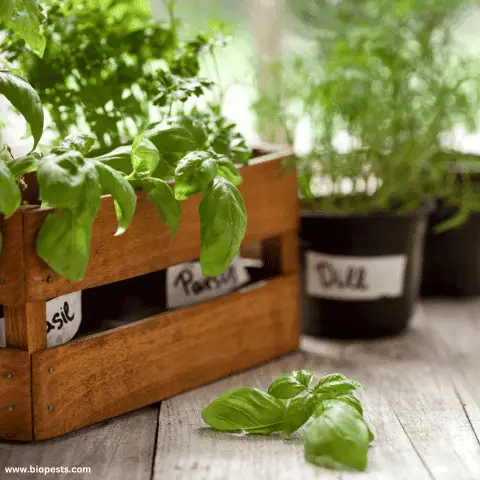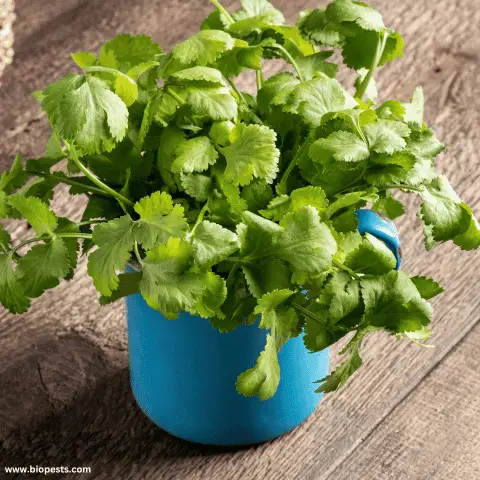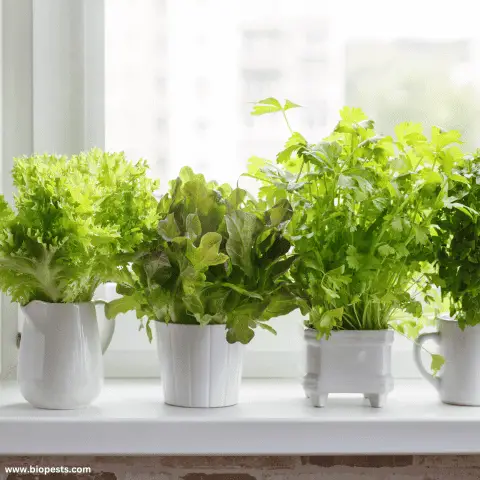Welcome to the wonderful world of herb gardens! Humans have cultivated these green havens for centuries to reap the countless health, culinary, and wellness benefits. Imagine being able to step into your kitchen and discover the power of nature at your fingertips. The journey is fulfilling and enlightening, from planting a tiny seed to nurturing a flourishing plant. In this article, we’ll explore everything you need to know about herb gardens, including choosing the perfect herbs, the secrets to successful planting and maintenance, and the art of harvesting and utilizing these incredible plants.

What Are The Benefits of Growing An Indoor Herb Garden?
Having an indoor herb garden is a wonderful way to bring life and freshness into your home, and owning one has many benefits. Not only do they look great, but growing herbs indoors is becoming increasingly popular due to their versatility and the many health benefits they provide. Here is a list of seven main advantages of growing your herbs:
1. Fresh herbs at your fingertips
Having an indoor herb garden means having fresh herbs available in your kitchen whenever needed. This is incredibly convenient for cooking, as well as for making drinks and teas. Instead of buying expensive, wilted herbs from the grocery store, you can pick exactly what you need right from your indoor garden.
2. Improved air quality
Many household plants are known for improving the air quality in a room, and herbs are no exception. They release oxygen while removing toxins such as formaldehyde and benzene from the air. So not only do they make your home smell great, but they can have significant health benefits as well.
3. Less waste
When you buy herbs from the store, they often come in plastic packaging and pre-cut portions that can quickly go to waste. By growing your herbs, you can cut exactly what you need, reducing waste and packaging.
4. You save time and money in the long run
With a little care, herbs can be harvested continuously, giving you an ongoing supply of fresh herbs without the need for constant purchases.
5. Easy to care for
Growing herbs indoors is easier than you might think. Many common herbs, such as basil, rosemary, and thyme, thrive indoors with just a little sunlight and water. They can be grown in pots, on a windowsill or in a kitchen garden, making them the perfect low-maintenance addition to your home.
6. Health benefits
Many herbs have proven health benefits, and having them readily available means you can use them more often. For example, basil reduces inflammation, while rosemary helps improve memory and concentration. Lavender has a calming effect, while thyme has antibacterial properties and can be used to soothe coughs and colds.
However, before using herbs for health remedies, it’s crucial to research their properties, contraindications, and appropriate dosages. Talking to a knowledgeable herbalist or healthcare provider is also recommended to ensure safe and beneficial use.
7. It is a rewarding process that gives you a real sense of achievement
By planting, nurturing, and using these herbs, you can develop a profound connection with nature while expanding your knowledge of personal health and natural remedies. As your garden flourishes, you’ll experience a genuine sense of accomplishment.
Creating an herbal garden is so much more than just a beautiful addition to your home. It’s an investment in your well-being, education, and sustainability. No matter the size of your garden, growing herbs at home can make wellness accessible, affordable, and eco-friendly. Whether you have a small windowsill or a dedicated yard, you can transform any space into your source of natural healing.
A Simple Guide to Choosing the Right Plants for Your Indoor Herb Garden
When it comes to choosing the right plants for your indoor herb garden, it can be overwhelming to determine what plants are the best fit for you. There are many factors to consider, like herbs’ taste, growth habits, and the amount of light they need. Luckily, I’ve got your back! Here’s a simple guide to selecting the right plants for your indoor herb garden.

How To Choose Herbs For Your Indoor Herb Garden
First, decide which herbs you want to invest in or have a particular preference. It could be basil, dill, parsley, thyme, or cilantro. (More on that further on in my article.)
Always remember that you might need to select plants with similar growth requirements and compatible flavors that will thrive in your indoor herb garden.
Herbs can be annual, perennial, or biennial.
Annual herbs like basil, coriander, and dill bring fresh flavors to your meals but require replanting each year. On the other hand, perennials like rosemary, thyme, and mint are the gift that keeps giving and growing for several years.
For biennials like parsley and caraway, a two-year cycle is needed for them to complete their lifecycle.
Most perennial herbs may become dormant during the cooler months, but fear not, as they will return to life when the weather warms up.
Hardy herbs like rosemary and thyme can brave colder climates with suitable winter protection, surviving from year to year.
So whether you choose annuals, perennials, or biennials, herbs will spice up your garden and culinary adventures!
When is the best planting time for an indoor herb garden?
Generally speaking, you can grow an indoor herb garden all year round; however, I strongly suggest waiting for the spring. It’s essential to ensure that the temperature in your indoor herb garden mimics the outdoor plant’s natural habitat. However, you can plant any time of the year by replicating the right conditions. You need to make sure that you are not placing the plants in an area that is too cold or too hot. Plants thrive well in temperatures between 60 to 70 degrees Fahrenheit (16 – 21 degrees Celsius).
What Are The Light Requirements For An Indoor Herb Garden?
Light is essential for the growth and photosynthesis of plants. Therefore, it is crucial to consider your indoor herb garden’s light requirements before selecting plants. Generally, most herbs need at least six hours of direct sunlight daily, which can be challenging to replicate indoors. Some herbs, however, can also grow well under artificial light. For best results, place your indoor herb garden where it can receive sufficient light from a nearby window or under grow lights. Not sure what grow lights are? Check my article here, it has all the information you need about grow lights.
Seeds, Seedlings, or cuttings? What’s The Best Way To Start Your Indoor Herb Garden?
You can start your indoor garden with seeds, cuttings, or even pre-grown seedlings. Just follow a few simple steps for success.
If you choose to start from seeds, make sure to read the instructions on the packet. They’ll give you the best tips for growing healthy herbs. Check these recycled paper seed starter pots if you choose the seeds option. They are organic and biodegradable 🙂
You can root cuttings in water first and then transplant them to your garden. It’s a great way to expand your herb collection.

When using pre-grown seedlings, remember to loosen the root ball before planting. This helps the roots spread out and establish themselves.
And don’t forget about planting depth! Each herb has its preferred depth. For example, basil seeds should be covered with about 1/4 inch of soil. On the other hand, rosemary cuttings or seedlings should be planted a bit deeper to cover the root system.
After planting, give your herbs a good drink of water. Make sure the soil is moist but not overly wet. Happy planting!
What Are The Most Popular Herb Choices for Indoor Herb Gardening?
If you’re not sure where to start, here are some of the most popular herbs for indoor herb gardening. Basil is an excellent choice for an indoor herb garden as it is relatively easy to grow and can be used in several dishes. Chives grow well in almost any light conditions, making them one of the best plants for indoor growing. Parsley is also a great choice for an indoor herb garden, as it adds a lovely touch of green to any room. Thyme is another popular choice that can be used fresh or dried. Cilantro is also easy to grow and can be used in several dishes.

Herbaceous Harmony: Which Culinary Herbs Have Similar Growing Requirements?
Each herb has its unique growing requirements that can be challenging to master. Let’s explore which culinary herbs have similar growing requirements, making planning and growing your dream herb garden easier.
Mediterranian Herbs (Basil, Rosemary, Thyme, Oregano, Sage)
Mediterranean herbs are popular and versatile herbs that thrive in warm and sunny climates. They are perfect for dry and poor soil as they require low levels of water and nutrients. Basil is the most sensitive of all Mediterranean herbs and thrives when it is protected from strong winds and frost. Basil is an annual herb that prefers warm climates and fertile, well-drained soil. Its leaves, starring in Italian and Asian cooking, also can alleviate digestive issues, inflammation, and bacterial infections. A sun-loving plant, basil needs regular watering, particularly during dry periods.
Thyme, oregano, and sage, on the other hand, are hardy and can tolerate a wide range of growing conditions and soil types. They all prefer full sun, well-draining soil, and moderate water levels.

Rosemary, a perennial plant native to the Mediterranean region, is highly valued for its aromatic leaves – a staple in meat dishes and bread. Known for its mood-enhancing abilities, rosemary does well in full sunlight and dry, well-drained soil. As it is a slow grower, it is often more practical to buy young plants rather than starting from seeds. Tolerant of summer heat and drought, rosemary requires minimal care once established, although it may need protection in colder zones.
Aromatic Herbs (Lavender, Chamomile, Mint)
Aromatic herbs are loved for their delightful fragrances and medicinal properties. They prefer to grow in loamy soils with good drainage and moderate fertility. Lavender, chamomile, and mint require full sun to partial shade to thrive.
Chamomile is a cold-hardy plant that can tolerate frost and grow in many regions.
Lavender flourishes in fully sunny conditions and requires dry, well-drained soil to thrive. The dried flowers are used extensively in the perfume industry and serve as a wonderful culinary ingredient and a natural remedy for stress relief. Lavender is also drought-tolerant, with minimal watering needs, yet it may need some form of protection against harsh conditions in colder climates.
Mint, one of the most versatile herbs, is straightforward to grow, thriving in moist, partially shaded settings. Its leaves, spread across tea, salads, sauces, and desserts, can soothe digestive troubles and headaches. Mint plants, however, can aggressively spread, taking over other spaces in the garden. Therefore, cultivating it in containers or enclosed patches is advisable to prevent its invasive tendencies.
Leafy Greens (Parsley, Cilantro, Chives)
Leafy herbs add freshness and color to salads, soups, and stews. They prefer moist soil, rich in organic matter and moderate levels of sunlight. Parsley and cilantro like cool and shady conditions to prevent bolting, while chives prefer full sun. Cilantro is a fast-growing herb that requires regular watering, while parsley and chives like to be kept moist but not waterlogged.

Root Herbs (Ginger, Turmeric)
Root herbs are a bit more challenging to grow but rewarding once they are established. They require damp soil, rich in organic matter, and warm temperatures. Ginger and turmeric are tropical plants that require full to partial shade, high humidity, and protection from strong winds and frost. They also need regular watering and well-drained soil to prevent root rot.
All-Purpose Herbs (Dill, Fennel)
Last but not least, we have all-purpose herbs like dill and fennel that are versatile and easy to grow. They require partial shade to full sun, well-drained soil, and moderate moisture levels. Dill thrives in cool and moist conditions and benefits from regular feedings, while fennel prefers warm temperatures and needs some space to grow and develop.
Maintaining And Harvesting Your Herb Garden
Regular maintenance of your herbs will ensure healthy growth. Most herbs prefer soil on the drier side, so be careful not to overwater. A good rule of thumb is to water when the top inch of soil feels dry. Regularly check your plants for any signs of pests or disease, which should be treated immediately. Most herbs appreciate a good trim, so don’t hesitate to prune your plants to encourage bushier growth. This also gives you a regular supply of fresh herbs.
Harvesting Your Herbs
While harvesting herbs, it’s essential to remember that less is more.
The ideal time to harvest your herbs varies greatly depending on the species and the parts you intend to use. Early morning hours – once the dew has evaporated and before the sun gets excessively hot – is the most opportune time to collect herbs. Leaves should be picked before the plant begins to flower, as this is when the oils that give them their unique flavor and scent are at their peak. To harvest, pinch off leaves and stems near the base.
While herbs like rosemary, thyme, and mint are best harvested pre-flowering, other herbs such as dill and coriander should be collected post-flowering when seeds start to form. When it comes to root herbs like turmeric and ginseng, the optimal time for collection is late fall or early spring as this is when the plant is dormant and the roots are brimming with stored energy.
The Best Way To Storage Your Herbs
After harvesting, herbs must be preserved as swiftly as possible to maintain their freshness. For short-term usage, herbs can be stored in the refrigerator wrapped in a damp cloth.
For long-term storage, drying, and freezing are most common. To dry herbs, bundle and hang them upside down in a warm, dry, dark place. Once thoroughly dried, store them in airtight jars or containers away from light and heat.
Freezing is another efficient way to store herbs. Chop them finely, place them in ice cube trays, cover them with water, and freeze them. Once frozen, transfer the herb cubes to freezer bags, where they can be easily retrieved and used as needed.
Conclusion:
In summary, owning an indoor herb garden has a lot of benefits, from bringing fresh, flavorful herbs into your kitchen to removing toxins from the air and providing natural health benefits. Whether you’re an experienced gardener or just starting, growing herbs indoors is a great way to add beauty, freshness, and sustainability to your home. So why not get started today and enjoy the many benefits of your indoor herb garden?
Some of the links above are affiliate links, meaning at no additional cost to you, I will earn a commission if you click through and make a purchase.

